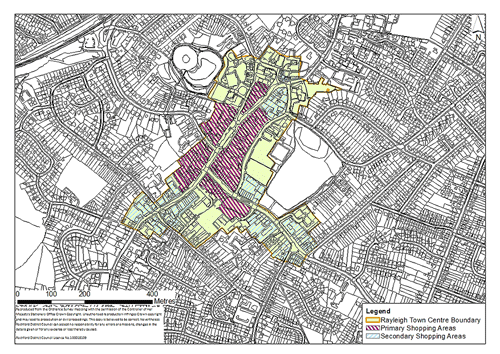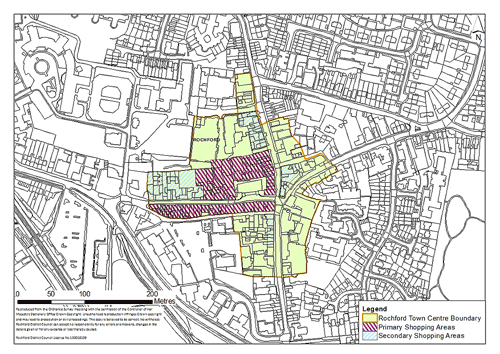Allocations Submission Document
(1) 9. Town Centre and Primary Shopping Area Boundary Allocations
Introduction
There are three town centres in the District; Rayleigh, Rochford and Hockley.
National policy places great importance on supporting and enhancing the vitality and vibrancy of town centres. Town Centres are defined as the “Area defined on the local authority’s proposal map, including the primary shopping area and areas predominantly occupied by main town centre uses within or adjacent to the primary shopping area.” within the NPPF (Annex 2; page 57). Main town centre uses identified in the NPPF include retail development, leisure, entertainment facilities, the more intensive sport and recreation uses, offices, and arts, culture and tourism development (Annex 2; page 53).
The 2008 Retail and Leisure Study found that Rochford District suffers from expenditure leakage to out-of-district centres. Rayleigh, being the largest centre in the District does not suffer as greatly, and has the highest spending retention levels. Rochford and Hockley on the other hand performed poorly when it came to expenditure retention.
In recognition of the importance of town centres, not simply for retail but also as a focus for community and leisure activities, the Council has resolved to produce Area Action Plans for Hockley, Rayleigh and Rochford centres. However, in the interim, it is important to allocate land with regards to the District’s town centres to ensure they continue to perform their valuable functions. Town centre boundaries need to be defined, as well as primary shopping areas.
The primary shopping area is a “defined area where retail development is concentrated (generally comprising the primary and those secondary frontages which are adjoining and closely related to the primary shopping frontage” (NPPF, Annex 2; page 55).
The NPPF also notes that the “primary frontages are likely to include a high proportion of retail uses which may include food, drinks, clothing and household goods. Secondary frontages provide greater opportunities for a diversity of uses such as restaurants, cinemas and businesses.” (Annex 2; page 55).
Policy TCB1 – Rayleigh
Context:
Rayleigh is the principal town within the District, as highlighted within the 2008 Retail and Leisure Study, and has both strong comparison and strong convenience sectors. It was also noted that Rayleigh consists of a range of unit sizes enabling a diverse range of retailers to be based there.
Rayleigh is the largest of the three centres in the District, and has the most comprehensive range of facilities. There are a range of retail outlets, with chain stores and independent stores making use of the variety of unit sizes available to them. However, there are opportunities for improvement within the centre. The Retail and Leisure Study recommended additional comparison floorspace be considered. The study also stated that there was little need to change the town centre boundary, and as such this will remain as existing, as illustrated in Figure 43. This boundary, however, may be reviewed through the preparation of the Rayleigh Area Action Plan.
The primary shopping area of Rayleigh is closely related to the primary shopping frontage where retail and other appropriate uses are concentred. Outside this area, the secondary shopping frontage area is located where a greater diversity of uses will be encouraged. The primary and secondary shopping frontages, as existing, are identified in Figure 43.
Redevelopment of the town centre through the Rayleigh Area Action Plan will have regard to Policy RTC4 of the Core Strategy. The Rayleigh Area Action Plan may entail amendments to the town centre boundary, primary and / or secondary shopping frontage areas.
Map:
Policy TCB2 – Rochford
Context:
Rochford was noted as being the second largest town centre in the District, in the 2008 Retail and Leisure Study, with strong comparison and convenience sectors, and also benefits from a unique layout. However several weaknesses were highlighted, including a lack of comparison goods floorspace, and a large number of smaller units. It was noted that there are opportunities for improvement within the centre.
The potential for Rochford as a centre was noted, particularly in reference to the Market Square which could act as a strong focal point. The Market Square is dominated by car parking.
The established town centre boundary for Rochford is considered to be too widely drawn, encompassing much residential development, to focus appropriate town centre uses within Rochford. A smaller boundary, refocusing the town centre, has been identified as set out in Figure 44. This boundary, however, may be reviewed through the development of the Rochford Area Action Plan.
The primary shopping area of Rochford is closely related to the primary shopping frontage where retail and other appropriate uses are concentred. Outside this area, the secondary shopping frontage area is located where a greater diversity of uses will be encouraged. The primary and secondary shopping frontages, as existing, are identified in Figure 44.
Redevelopment of the town centre through the Rochford Area Action Plan will have regard to Policy RTC5 of the Core Strategy. The Rochford Area Action Plan may entail amendments to the town centre boundary, primary and / or secondary shopping frontage areas.
Policy TCB3 – Hockley
Context:
Hockley was noted as being the smallest of the centres within the District, although it still benefits from a strong comparison goods sector and a good mix of independent traders. Opportunities were identified however in the 2008 Retail and Leisure Study with significant improvements available.
Hockley was noted in the 2008 Retail and Leisure Study as being the weakest of the three centres, with a number of opportunities for improvement.
Redevelopment of the town centre through the Hockley Area Action Plan will have regard to Policy RTC6 of the Core Strategy. The town centre boundary and the primary and secondary shopping frontages for Hockley will be determined in the Hockley Area Action Plan.


